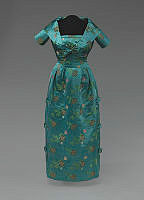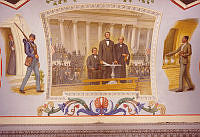Rubenstein Center Scholarship
Monument of a Crime
An 1899 newspaper article about the failure of the Freedman's Bank of the demolition of the building
MONUMENT OF A CRIME
Department of Justice Deserts a Fateful Building
Washington Post 25 June 1899
FAILURE OF FREEDMAN'S BANK
Big Brown-stone Building Across from the Treasury Was Once the Depository of the Savings of Thousands of ex-Slaves – Real Estate Speculation Ruined the Institution, with Which Many Noted Names Were Connected – Caused Much Distress.
Within a few days bids will be advertised for end opened for the removal of a building belonging to the government, which, for well nigh a quarter of a century, has been one of the most conspicuous features of the public architecture of the city, aside from the vast buildings of the Treasury, War, State and Navy, Post-office, and the Interior Departments. It is even more notable than some of these, situated as it is close to the Treasury Department, and near that intersection of streets which is the most crowded spot in the city, a place seen and known of all visitors.
The edifice from which the Department of Justice migrated has a history of romance and injustice which has few parallels in this city. It was in the late days of the war, or the early ones of reconstruction, that the Freedmen's Bureau came into existence. Its inception was from a fond, parental idea that the freed slaves, and especially those who fought in the war, ought to have some one to care for their money. Agencies were established at Beaufort and Norfolk. Then came the organization of the Freedmen's Savings and Trust Company, with fifty trustees or directors, most of them men of national reputation, among them being Peter Cooper and William C. Bryant. Headquarters were established at Washington, and the great building but recently vacated by the Department of Justice was erected at a cost of more than half a million dollars. That it was a fraud even in its construction is shown by the evidence given for many years back that it was unsafe. When the Freedmen's Bank failed about ten years after its organization, this part of its assets was sold to the government for just a quarter of a million, and the scene of a vast crime became the seat for the dispensation of the highest judicial opinion.
With the firm establishment of the bank, the broadest opportunities were afforded to the freedmen of the country to deposit their savings. Auxiliary banks were put in operation at New York, Baltimore, and Philadelphia, and no less than thirty-four agencies were scattered throughout the South. Money poured into the coffers of the institution, for it was an assumption that the credit of the whole Union was involved in its perpetuity and honest administration. During the ten years of its existence there were on the books upwards of 70,000 depositors, and the deposits aggregated more than $50,000,000. Gen. O. O. Howard was the President. He was noted as a gentleman of the highest Christian character, and every one had confidence in his abilities and probity. The late Frederick Douglass was another of the high officials of the institution, and his name was a guarantee to all the colored population of the States.
Beginning of the End
All the secrets of the operations of the bank will never be known, but a strange thing came to pass in 1870, when a movement was made in Congress to amend the charter of the bank to permit investment of the funds in real estate. The charter had provided for investment only in government or other easily negotiable securities whose stability could not be questioned. When the proposition was made to give the managers the legal privilege of engaging in real estate speculation it was easily recognized that there was literally a "nigger in the woodpile." It is to the lasting credit of Senator Simon Cameron, who had come forth from the furnace of the war with something more than the smell of fire on his garments, that he warned the Senate and House that such a step would surely mark the beginning of the end of the Freedmen's Bank. As eloquently as he had ever spoken on any subject, he inveighed against the granting of this fatal privilege, telling of his own experience with banks which invested in real estate, and found it impossible to realize on their holdings in time of distress. He made the plain prediction that in the presence of the craze for real estate investment the fictitious values that were quoted by reason of certain conditions, brought about by the existing District government, there would unquestionably be made bad investments, and that the institution would surely be bankrupted.
The lobby in support of the measure was stronger than any warning of wisdom or experience. The circle of real estate speculators, strong to this day when any opportunity is presented for a large investment of government or banking funds, was at that time in its first mature bloom and vigor, and in the vast moneys of the Freedmen's Savings and Trust Company they saw the avenue from sales at enormous profits, for it was well understood that some of the officials of the concern would not be any too careful in their estimate of the possible future value of squares and lots.
In the Panic Time
In an almost incredibly short time it was found that the bank was crippled. Within four years after the solemn warning uttered by Senator Cameron the doors of the big brownstone front across the Avenue from the north wing of the Treasury Department was closed, and tens of thousands of poor depositors who had placed all their savings there were plunged into mourning. At the time of the failure there were more than 61,000 depositors, and there was due there $2,937925. In those days of June, 1874, when it was announced that the bank had failed, there was gloom among the colored population of the country, and no end of stories of scandal everywhere. Gen. Howard was investigated, but he was found innocent of any moral or legal obliquity. Nobody – that beautifully indefinite individual – was found worthy of blame. It was a time of panic. Many banking institutions, supposed to be solid, had failed. It was a period of fearful turpitude as well. In church circles the Tilton-Beecher affair had shaken the social fabric to its foundation. The Boss Tweed revelations were at the front. Pacific Railroad, salary grab, safe burglary. District government affairs were in the public mouth all over the country. The failure of the Freedmen's Bank was but one of the many sensations which shook the public mind and confidence of men who had been at the head of local and national movements.
In great measure, the negro depositors in the Freedmen's Bank received the news of the failure with a sort of dumb despair. They but half understood the meaning of the occurrence. Nearly all of them believed that Uncle Sam was the backer of the institution in which they had placed their trust, and the blow therefore fell upon them with nothing like the violence that would have been felt if they had comprehended fully the extent of the disaster. Thousands of negro soldiers who had fought in the battles for the Union, and tens of thousands of others who had accepted the newfound toy of liberty as a harbinger of untold riches, had deposited every penny of savings, earned by work even more unceasing and laborious than that which they endured under the eye of the overseer, in this bank which was supposed to be as secure from pilfering or mismanagement as the store of golden apples within the walls of Paradise. There were few scenes of the character of those which are often witnessed in connection with the closing of a great banking institution. In all circles there was an abiding faith that the government would make good all claims against the depository. How greatly the depositors were mistaken is shown by a bit of history.
Failed to Make Good
Early in June 1874, three commissioners were appointed to take charge of the affairs of the bank. They served until 1881, when the whole business was turned over to the control of the Currency Bureau of the Treasury Department. During this period, five dividends were declared, amounting to $1,822,753. Of this sum there was paid $1,638,259. Nearly all of the remainder was barred by the act of Congress of February, 1881, and out of nearly $3,000,000 there has, therefore, been paid only a little more than one and one-half millions.
Hundreds of colored men in the District of Columbia can testify to the bankruptcy of the institution. One who is now a doorkeeper in one of the departments tells the writer how he had risen to the distinction of a contractor at the time of the boom in street building of the Shepherd regime; how the failure crippled him so that he could not pay his men and how it finally resulted in his financial ruin. An ex-slaveholder tells a pathetic story of one of the trusted servants of his household who, within a few years after the war, was wearing fine clothes and boasted of the hundreds of dollars he had on deposit in the Freedmen's Bank. He had almost starved himself and his family in his effort to get rich. Every dollar was swept away, and he gave up the game and died of a broken heart. The wreck and ruin that followed the cyclone of the failure could not be described in a library full of volumes, and Congress has up to the present time refused to apropriate [sic] money to reimburse the sufferers, most of whom are now beyond the reach of pecuniary relief. Once a year the Comptroller of the Currency makes a report upon the condition of the bank, a fine travesty which finds no echo of applause.





















